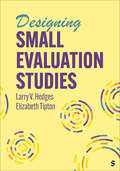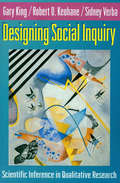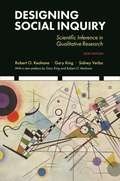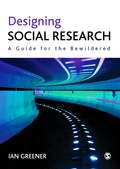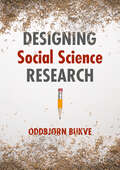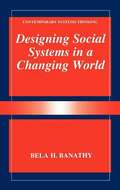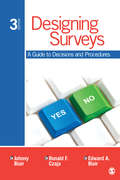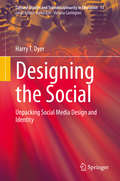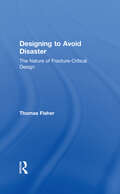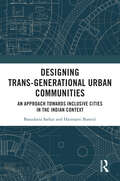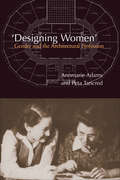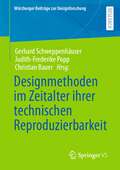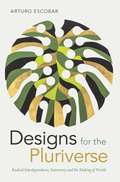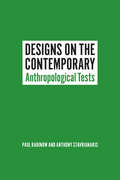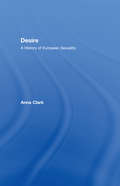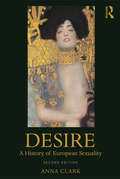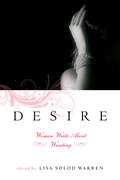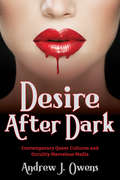- Table View
- List View
Designing Small Evaluation Studies
by Larry V. Hedges Elizabeth Tipton"The book will be an important addition to instruction in designs for causal inference in the field of education. It is long overdue." - Thomas J. Lipscomb, The University of Southern Mississippi This text describes how to design and analyze small efficacy or evaluation studies, typically carried out as part of the development of programs or interventions in areas such as education. The problem facing many researchers is how to design a study that is as small as possible, yet big enough to yield relatively unambiguous evidence about an intervention’s average effect. This text begins with an overview of validity, causal inference, statistics, effect sizes, and measurement. The authors then focus on designs for small, randomized trials, followed by a section on non-randomized causal designs: here they focus on three designs most useful for small studies including the non-equivalent control group, difference-in-difference, and interrupted time series designs. The final section summarizes the book, compares designs, discusses approaches to choosing a design, and provides guidance on reporting. Five case examples are used throughout the book to illustrate the material and there is a glossary of terms and concepts.
Designing Small Evaluation Studies
by Larry V. Hedges Elizabeth Tipton"The book will be an important addition to instruction in designs for causal inference in the field of education. It is long overdue." - Thomas J. Lipscomb, The University of Southern Mississippi This text describes how to design and analyze small efficacy or evaluation studies, typically carried out as part of the development of programs or interventions in areas such as education. The problem facing many researchers is how to design a study that is as small as possible, yet big enough to yield relatively unambiguous evidence about an intervention’s average effect. This text begins with an overview of validity, causal inference, statistics, effect sizes, and measurement. The authors then focus on designs for small, randomized trials, followed by a section on non-randomized causal designs: here they focus on three designs most useful for small studies including the non-equivalent control group, difference-in-difference, and interrupted time series designs. The final section summarizes the book, compares designs, discusses approaches to choosing a design, and provides guidance on reporting. Five case examples are used throughout the book to illustrate the material and there is a glossary of terms and concepts.
Designing Smart and Resilient Cities for a Post-Pandemic World: Metropandemic Revolution (Routledge Advances in Regional Economics, Science and Policy)
by Anthony Larsson Andreas HatzigeorgiouAre pandemics the end of cities? Or do they present an opportunity for us to reshape cities in ways making us even more innovative, successful, and sustainable? Pandemics such as COVID-19 (and comparable disruptions) have caused intense debates over the future of cities. Through a series of investigative studies, Designing Smart and Resilient Cities for a Post-Pandemic World: Metropandemic Revolution seeks to critically discuss and compare different cases, innovations and approaches as to how cities can utilise nascent and future digital technology and/or new strategies in order to build stronger resilience to better tackle comparable large-scale pandemics and/or disruptions in the future. The authors identify ten separate societal areas where future digital technology can impact resilience. These are discussed in individual chapters. Each chapter concludes with a set of proposed "action points" based on the conclusions of each respective study. These serve as solid policy recommendations of what courses of action to take to help increase the resilience in smart cities for each designated area. Securing resilience and cohesion between each area will bring about the metropandemic revolution. The book features a foreword by Nobel laureate Peter C. Doherty and an afterword by Professor of Urban Technologies, Carlo Ratti. It provides fresh and unique insights on smart cities and futures studies in a pandemic context, offers profound reflections on contemporary societal functions and the needs to build resilience and combines lessons learned from historical pandemics with possibilities offered by future technology.
Designing Social Inquiry
by Gary King Robert O. Keohane Sidney VerbaGuide to qualitative research design.
Designing Social Inquiry: Scientific Inference in Qualitative Research, New Edition
by Gary King Robert O. Keohane Sidney VerbaThe classic work on qualitative methods in political scienceDesigning Social Inquiry presents a unified approach to qualitative and quantitative research in political science, showing how the same logic of inference underlies both. This stimulating book discusses issues related to framing research questions, measuring the accuracy of data and the uncertainty of empirical inferences, discovering causal effects, and getting the most out of qualitative research. It addresses topics such as interpretation and inference, comparative case studies, constructing causal theories, dependent and explanatory variables, the limits of random selection, selection bias, and errors in measurement. The book only uses mathematical notation to clarify concepts, and assumes no prior knowledge of mathematics or statistics.Featuring a new preface by Robert O. Keohane and Gary King, this edition makes an influential work available to new generations of qualitative researchers in the social sciences.
Designing Social Research: A Guide for the Bewildered
by Ian GreenerWritten in plain language, this guide for students in sociology is intentionally designed to be shorter and more readable than other similar texts. It gives practical advice on the process of designing and doing social research, and also gives students background in the vocabulary and philosophy they need to understand the research they are undertaking. The goal is for students to be able to engage in discussion not only about the differences between methods, but in the reason for those differences. After an overview of the language of social science research and discussion of what makes a good research question, the book covers methods and approaches such as surveys and questionnaires, sampling and statistics, ethnography, and dealing with qualitative data. Some advanced topics covered include causality in research and dealing with time in social research. There is also advice on writing the research report and putting together literature reviews. Chapter summaries and examples are included. Greener teaches in the School of Applied Social Sciences at Durham University. Annotation ©2011 Book News, Inc. , Portland, OR (booknews. com)
Designing Social Research: A Guide for the Bewildered
by Ian GreenerDesigning Social Research aims to guide students and new researchers using everyday non-jargonised language through the jungle of setting up their own research study. Ian Greener provides readers an accessible combination of guidance on how to practically plan one's research and understand the underpinning methodological principles that should inform the decisions we make about the methods we plan to use. This is the perfect starter book for anyone looking to design their own research project and make sense of and justify the many decisions that go into the research design process. The goal throughout is to enable students and researchers to assess the appropriateness of a range of methods and to get understanding of the strengths and limitations of different approaches to research. Greener highlights key debates in the field - both philosophical and practical - and presents them in such a way that they remain constantly relevant to research practice of his readers. Coverage includes: - Framing an effective research question/problem; - Examining the jargon of social research; - The links between theory, methodology and method; - The role of literature reviewing in research design; - Managing and planning the research process; - Sampling; - Qualitative designs; - Quantitative designs; - Mixed methods designs; - Data analysis. Designing Social Research will be ideal first reading for M-level students and undergraduates planning significant research projects for their dissertations. It will also be invaluable to first year PhD students considering how they will go about their research projects. Available with Perusall—an eBook that makes it easier to prepare for class Perusall is an award-winning eBook platform featuring social annotation tools that allow students and instructors to collaboratively mark up and discuss their SAGE textbook. Backed by research and supported by technological innovations developed at Harvard University, this process of learning through collaborative annotation keeps your students engaged and makes teaching easier and more effective. Learn more.
Designing Social Science Research
by Oddbjørn BukveThis book presents different research designs, their respective purposes and merits as well as their underlying assumptions. Research designs are characterised by a certain combination of knowledge aims and strategies for data production. An adequate design is the key to carrying out a successful research project. Nevertheless, the literature on design is scarce, compared to the literature on methods. This book clarifies the basic distinction between variable-oriented designs and case designs, and proceeds to integrated, comparative and intervention-oriented designs. A step-by-step guide to the design process and the choices to make is also included. The book's clear style makes it an excellent guide for master students and PhD students doing their first research exercises, while it is also useful for more experienced researchers who want to broaden their design repertoire and keep up to recent innovations in the field of research design.
Designing Social Systems In A Changing World
by Bela H. BanathyIn this original text/reference, Bela H. Banathy discusses a broad range of design approaches, models, methods, and tools, together with the theoretical and philosophical bases of social systems design. he explores the existing knowledge bases of systems design; introduces and integrates concepts from other fields that contribute to design thinking and practice; and thoroughly explains how competence in social systems design empowers people to direct their progress and create a truly participative democracy. Based on advanced learning theory and practice, the text's material is enhanced by helpful diagrams that illustrate novel concepts and problem sets that allow readers to apply these concepts.
Designing Surveys: A Guide to Decisions and Procedures
by Johnny Blair Dr Ronald F. Czaja Dr Edward BlairWritten with the needs and goals of a novice researcher in mind, this fully updated Third Edition of Designing Surveys by Johnny Blair, Ronald F. Czaja, and Edward A. Blair provides an accurate account of how modern surveys are actually designed and conducted. Much more than a “how-to” guide, this up-to-date and accessible book presents the material in a social science context and teaches readers to think through decisions about sample design, questionnaire development, and data collection, rather than simply following prescriptive advice that may not be appropriate to particular practical situations. In addition to providing examples of alternative procedures, Designing Surveys shows how classic principles and recent research guide decision-making—from setting the basic features of the survey design to implementing instrument development, testing, and data collection. The new edition covers new developments in data collection technologies, provides a more comprehensive treatment of questionnaire development and pretesting, and includes completely new chapters on sample design and selection.
DESIGNING THE 2010 CENSUS: First Interim Report
by Panel on Research on Future Census MethodsA report on Designing the 2010 Census
Designing the Creative Child: Playthings and Places in Midcentury America (Architecture, Landscape and Amer Culture)
by Amy F. OgataThe postwar American stereotypes of suburban sameness, traditional gender roles, and educational conservatism have masked an alternate self-image tailor-made for the Cold War. The creative child, an idealized future citizen, was the darling of baby boom parents, psychologists, marketers, and designers who saw in the next generation promise that appeared to answer the most pressing worries of the age. Designing the Creative Child reveals how a postwar cult of childhood creativity developed and continues to this day. Exploring how the idea of children as imaginative and naturally creative was constructed, disseminated, and consumed in the United States after World War II, Amy F. Ogata argues that educational toys, playgrounds, small middle-class houses, new schools, and children&’s museums were designed to cultivate imagination in a growing cohort of baby boom children. Enthusiasm for encouraging creativity in children countered Cold War fears of failing competitiveness and the postwar critique of social conformity, making creativity an emblem of national revitalization.Ogata describes how a historically rooted belief in children&’s capacity for independent thinking was transformed from an elite concern of the interwar years to a fully consumable and aspirational ideal that persists today. From building blocks to Gumby, playhouses to Playskool trains, Creative Playthings to the Eames House of Cards, Crayola fingerpaint to children&’s museums, material goods and spaces shaped a popular understanding of creativity, and Designing the Creative Child demonstrates how this notion has been woven into the fabric of American culture.
Designing the Social: Unpacking Social Media Design and Identity (Cultural Studies and Transdisciplinarity in Education #11)
by Harry T. DyerThis book uses data collected from in-depth interviews with young people over the course of a year to explore the complex role of social media in their lives, and the part it plays in shaping how they understand and present their identity to a broad public on a wide array of platforms. Using this data, the book proposes and develops a new theoretical framework for understanding identity performances. Comic Theory, detailed in this book, centres on a consideration of the role of social media design in shaping identity, and explores the ways in which socio-culturally grounded users engage in acts of compromise, novelty, and negotiation with social media designs and digital technologies to produce unique identity performances.Positioned within the field of educational research, this book overtly challenges assumptions and myths about the internet as a neutral source of knowledge, instead exploring the way in which designs and technologies shape who we interact with and how we understand what it is to be social. Moving beyond the over-used ‘digital natives’ paradigm, this book makes a clear case that educators and education researchers need to move beyond a focus on coding and digital skills alone, highlighting the pressing need to take explicit account of the overlaps between digital technology, culture, and education.
Designing To Avoid Disaster: The Nature of Fracture-Critical Design
by Thomas FisherRecent catastrophic events, such as the I-35W bridge collapse, New Orleans flooding, the BP oil spill, Port au Prince's destruction by earthquake, Fukushima nuclear plant's devastation by tsunami, the Wall Street investment bank failures, and the housing foreclosure epidemic and the collapse of housing prices, all stem from what author Thomas Fisher calls fracture-critical design. This is design in which structures and systems have so little redundancy and so much interconnectedness and misguided efficiency that they fail completely if any one part does not perform as intended. If we, as architects, planners, engineers, and citizens are to predict and prepare for the next disaster, we need to recognize this error in our thinking and to understand how design thinking provides us with a way to anticipate unintended failures and increase the resiliency of the world in which we live. In Designing to Avoid Disaster, the author discusses the context and cultural assumptions that have led to a number of disasters worldwide, describing the nature of fracture-critical design and why it has become so prevalent. He traces the impact of fracture-critical thinking on everything from our economy and politics to our educational and infrastructure systems to the communities, buildings, and products we inhabit and use everyday. And he shows how the natural environment and human population itself have both begun to move on a path toward a fracture-critical collapse that we need to do everything possible to avoid. We designed our way to such disasters and we can design our way out of them, with a number of possible solutions that Fisher provides.
Designing Trans-Generational Urban Communities: An Approach towards Inclusive Cities in the Indian Context
by Basudatta Sarkar Haimanti BanerjiThis book examines the inclusiveness of city planning and design to address gaps in policies, strategies and design guidelines for developing trans-generational urban communities in India. Identifying key factors and measurable indicators of trans-generational cities within social, physical, and economic dimensions, the volume highlights the need for establishing age-friendly and child-friendly cities and communities. Through a systematic process of ground data collection, the book explores issues related to health, daily routine, lifestyle, recreation, and socialization within vulnerable groups, considering their physical and cognitive limitations for framing adaptable policies. The volume integrates a bottom-up and top-down approach by integrating the needs and perception of the target group obtained from extensive groundwork with the available theories and literature in allied fields adopting a step-by step synchronized methodology. It also presents the way forward for framing policies focusing on socio-economic security, participation, dignity, care, and self-fulfillment.Offering rich empirical research, this book will be useful for students, teachers and researchers of architecture, urban design, urban geography, urban studies, urban development and planning, and child psychology. It will also be of interest to urban planners and designers, policy planners, local government authorities and professionals engaged in the discipline.
Designing Transformative Multicultural Initiatives: Theoretical Foundations, Practical Applications and Facilitator Considerations
by Sherry K. WattHigher education is facing a perfect storm as it contends with changing demographics, shrinking budgets and concerns about access and cost, while underrepresented groups are voicing dissatisfaction with campus climate and demanding changes to structural inequities. <p><p> This book argues that colleges and universities need both to centralize the value of diversity and inclusion and employ a set of strategies that are enacted at all levels of their institutions. It argues that individual and institutional change efforts can only be achieved by implementing “diversity as a value” – that is embracing social change efforts as central and additive rather than episodic and required – and provides the research and theoretical frameworks to support this approach, as well as tools and examples of practice that accomplish change. <p><p> The contributors to this book identify the elements that drive successful multicultural initiatives and that strengthen the effectiveness of campus efforts to dismantle systemic oppression, as well as the individual and organization skills needed to manage difference effectively. Among these is developing the capacity of administrators, faculty and student affairs professionals as conscious scholar practitioners to sensitively manage conflicts on campus, deconstruct challenging structures and reconstruct the environment intentionally to include in respectful ways experiences of historically marginalized groups and non-dominant ways of being in the world. <p><p> The books’ focus on developing capacities for multicultural competence aligns with higher education’s increasing emphasis on civic engagement and institutional goals promote skills to interact in meaningful and responsible ways around difference, whether of people, ideas or identities. <p><p> Designing Transformative Multicultural Initiatives provides guiding principles and practical strategies to successfully transform higher education to become fully inclusive and advance the success of all constituents and stakeholders.
'Designing Women': Gender and the Architectural Profession
by Annmarie Adams Peta TancredHistorically, the contributions of women architects to their profession have been minimized or overlooked. 'Designing Women' explores the tension that has existed between the architectural profession and its women members. It demonstrates the influence that these women have had on architecture in Canada, and links their so-called marginalization to the profession's restrictive and sometimes discriminatory practices. Co-written by an architectural historian and a sociologist, this book provides a welcome blend of disciplinary approaches. The product of much original research, it looks at issues that are specific to architecture in Canada and at the same time characteristic of many male-dominated workplaces. Annmarie Adams and Peta Tancred examine the issue of gender and its relation to the larger dynamics of status and power. They argue that many women architects have reacted with ingenuity to the difficulties they have faced, making major innovations in practice and design. Branching out into a wide range of alternative fields, these women have extended and developed what are considered to be the core specializations within architecture. As the authors point out, while the profession designs women's place within it, women design buildings and careers that transcend that narrow professional definition.
Designmethoden im Zeitalter ihrer technischen Reproduzierbarkeit (Würzburger Beiträge zur Designforschung)
by Gerhard Schweppenhäuser Judith-Frederike Popp Christian BauerDie Beiträge in diesem Band spiegeln den Stand der Reflexions- und Forschungsprozesse an der Fakultät Gestaltung der TH Würzburg-Schweinfurt, der HBKsaar und der New Design University in St. Pölten. Sie repräsentieren einen Prozess der Aufklärung, dessen Prüfstein Walter Benjamins Frage ist, wie sich ›die Art und Weise der Sinneswahrnehmung‹ geschichtlich gewachsener Kollektive durch neue Medientechnologien verändert.
Designs for an Anthropology of the Contemporary
by Paul Rabinow George E. Marcus James D. Faubion Tobias ReesIn this compact volume two of anthropology's most influential theorists, Paul Rabinow and George E. Marcus, engage in a series of conversations about the past, present, and future of anthropological knowledge, pedagogy, and practice. James D. Faubion joins in several exchanges to facilitate and elaborate the dialogue, and Tobias Rees moderates the discussions and contributes an introduction and an afterword to the volume. Most of the conversations are focused on contemporary challenges to how anthropology understands its subject and how ethnographic research projects are designed and carried out. Rabinow and Marcus reflect on what remains distinctly anthropological about the study of contemporary events and processes, and they contemplate productive new directions for the field. The two converge in Marcus's emphasis on the need to redesign pedagogical practices for training anthropological researchers and in Rabinow's proposal of collaborative initiatives in which ethnographic research designs could be analyzed, experimented with, and transformed. Both Rabinow and Marcus participated in the milestone collection Writing Culture: The Poetics and Politics of Ethnography. Published in 1986, Writing Culture catalyzed a reassessment of how ethnographers encountered, studied, and wrote about their subjects. In the opening conversations of Designs for an Anthropology of the Contemporary, Rabinow and Marcus take stock of anthropology's recent past by discussing the intellectual scene in which Writing Culture intervened, the book's contributions, and its conceptual limitations. Considering how the field has developed since the publication of that volume, they address topics including ethnography's self-reflexive turn, scholars' increased focus on questions of identity, the Public Culture project, science and technology studies, and the changing interests and goals of students. Designs for an Anthropology of the Contemporary allows readers to eavesdrop on lively conversations between anthropologists who have helped to shape their field's recent past and are deeply invested in its future.
Designs for the Pluriverse: Radical Interdependence, Autonomy, and the Making of Worlds (New Ecologies for the Twenty-First Century)
by Arturo EscobarIn Designs for the Pluriverse Arturo Escobar presents a new vision of design theory and practice aimed at channeling design's world-making capacity toward ways of being and doing that are deeply attuned to justice and the Earth. Noting that most design—from consumer goods and digital technologies to built environments—currently serves capitalist ends, Escobar argues for the development of an “autonomous design” that eschews commercial and modernizing aims in favor of more collaborative and placed-based approaches. Such design attends to questions of environment, experience, and politics while focusing on the production of human experience based on the radical interdependence of all beings. Mapping autonomous design’s principles to the history of decolonial efforts of indigenous and Afro-descended people in Latin America, Escobar shows how refiguring current design practices could lead to the creation of more just and sustainable social orders.
Designs on the Contemporary: Anthropological Tests
by Paul Rabinow Anthony Stavrianakis"Designs on the Contemporary"apursues the challenge of how to design and put into practice strategies for inquiring into the intersections of philosophy and anthropology. Drawing on the conceptual repertoires of Max Weber, Michel Foucault, and John Dewey, among others, Paul Rabinow and Anthony Stavrianakis reflect on and experiment with how to give form to anthropological inquiry and its aftermath, with special attention to the ethical formation and ramifications of this mode of engagement. aa a a aThe authors continue their prior explorations of the contemporary in past works: How to conceptualize, test, and give form to breakdowns of truth and conduct, as well as how to open up possibilities for the remediation of such breakdowns. They offer a surprising and contrasting pair of case studies of two figures who engaged with contemporary breakdowns: Salman Rushdie and Gerhard Richter. Approaching RichterOCOs artistic struggles with form and technique in the long wake of modernism and RushdieOCOs struggles to find a narrative formOCoas well as a form for livingOCoto respond to the Iranian fatwa issued against him, they show how both men formulated different new approaches to anthropology for the twenty-first century. "
Desire: A History of European Sexuality
by Anna Clark‘… the rich range of historical information that Clark weaves into her chapters... makes this ambitious overview of sex in Europe a highly accessible and successful endeavour.’ – Times Higher Education Supplement 'Provides a valuable overview of the history of sexuality in Europe since classical antiquity, synthesising as it does a mass of studies of specific regions and periods which have appeared during the last two decades.' Lesley Hall, Wellcome Library, UK Desire: A History of European Sexuality is a sweeping survey of sexuality in Europe from the Greeks to the present day. It traces two concepts of sexual desire that have competed in European history: desire as dangerous, polluting, and disorderly; and desire as creative, transcendent, even revolutionary. This book follows these changing attitudes toward sexuality through the major turning points of European history. Written in a lively and engaging style, the book contains many fascinating anecdotes drawing on a rich array of sources including poetry, novels, pornography and film as well as court records, autobiographies and personal letters. While Anna Clark builds on the work of dozens of historians, she also takes a fresh approach and introduces the concepts of twilight moments and sexual economies. Desire integrates the history of heterosexuality with same-sex desire, and focuses on the emotions of love as well as the passions of lust, the politics of sex as well as the personal experiences.
Desire: A History of European Sexuality
by Anna ClarkA sweeping survey of sexuality in Europe from the Greeks to the present, Desire: A History of European Sexuality follows changing attitudes to two major concepts of sexual desire – desire as dangerous, polluting, and disorderly, and desire as creative, transcendent, even revolutionary – through the major turning points of European history. Chronological in structure, and wide ranging in scope, Desire addresses such topics as sex in ancient Judaism, Christianity, and Islam, sexual contact and culture clash in Spain and colonial Mesoamerica, new attitudes toward sexuality in the seventeenth and eighteenth centuries, and sex in Bolshevik Russia and Nazi Germany. The book introduces the concept of "twilight moments" to describe activities seen as shameful or dishonorable, but which were tolerated when concealed by shadows, and integrates the history of heterosexuality with same-sex desire, as well as exploring the emotions of love and lust as well as the politics of sex and personal experiences. This new edition has been updated to include a new chapter on sex and imperialism and expanded discussions of Islam and trans issues. Drawing on a rich array of sources, including poetry, novels, pornography, and film, as well as court records, autobiographies, and personal letters, and written in a lively, engaging style, Desire remains an essential resource for scholars and students of the history of European sexuality, as well as women’s and gender history, social and cultural history and LGBTQ history.
Desire: Women Write About Wanting
by Lisa Solod WarrenA captivating collection of essays, Desire delves headfirst into its subject matter and explores the complexity of desire with essays about the things women want, crave, lust after, and covet. An extraordinary group of writers tackle difficult and taboo subjects, from Debra Magpie Earling's desire to hurt someone, to New York Times writer S. S. Fair's less than diminishing sensual and sexual desire, despite her increasing age, to Julia Serano's strong emotional impulse to be a woman before she decided to transition from male to female.Many of these essayists examine the feelings and experiences which surround the things they want but can't-or shouldn't-have. The reasons such desires are taboo are often personal and range from social conventions and religious teachings to more concrete laws and rules. Desire makes the private public and illuminates the rich and varied desires women have.
Desire After Dark: Contemporary Queer Cultures and Occultly Marvelous Media
by Andrew J. OwensSince the 1960s, the occult in film and television has responded to and reflected society's crises surrounding gender and sexuality.In Desire After Dark, Andrew J. Owens explores media where figures such as vampires and witches make use of their supernatural knowledge in order to queer what otherwise appears to be a normative world. Beginning with the global sexual revolutions of the '60s and moving decade by decade through "Euro-sleaze" cinema and theatrical hardcore pornography, the HIV/AIDS crisis, the popularity of New Age religions and witchcraft, and finally the increasingly explicit sexualization of American cable television, Owens contends that occult media has risen to prominence during the past 60 years as a way of exposing and working through cultural crises about queerness. Through the use of historiography and textual analyses of media from Bewitched to The Hunger, Owens reveals that the various players in occult media have always been well aware that non-normative sexuality constitutes the heart of horror's enduring appeal. By investigating vampirism, witchcraft, and other manifestations of the supernatural in media, Desire After Dark confirms how the queer has been integral to the evolution of the horror genre and its persistent popularity as both a subcultural and mainstream media form.
